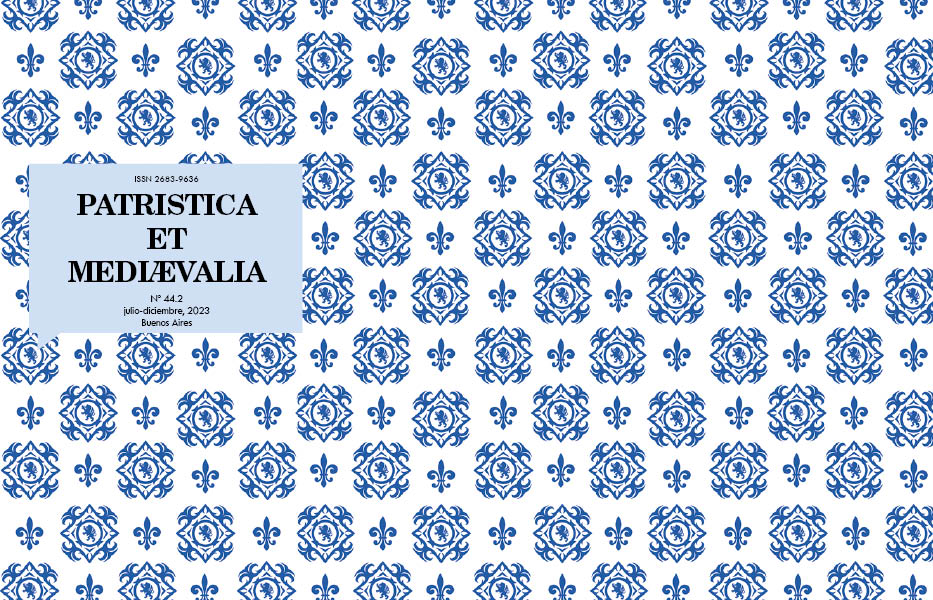Augustine in the phenomenology of the 20th century
Abstract
This paper delves into how Augustine of Hippo’s ideas were received and interpreted in phenomenology throughout the 20th century. The author categorizes this reception into several themes and approaches and their corresponding authors. Initially, the focus is on the “phenomenological origins” (Husserl, Heidegger, and Arendt), highlighting Augustine’s interpretation in a German context. Following that, the author analyzes what he phrases as the “hermeneutical turn” (Gadamer and Ricoeur) within the framework of Augustine’s French readings. Lastly, he examines what he defines as “phenomenological descriptions” (Marion and Chrétien).Downloads
References
Augustinus Hipponensis (1865). Sermones. Ed. Migne, J.-P. París. (PL 38).
Augustinus Hipponensis (1962). De doctrina christiana. De vera religione. Ed. Daur, K.D, Martin, J. Turnhout: Brepols. (CCSL 32).
Augustinus Hipponensis (1968). De Trinitate (Libri XII-XV). Ed. Mountain, W. J. Aux. Glorie, Fr. Turnhout: Brepols. (CCSL 50A).
Augustinus Hipponensis (1981). Confessionum. Ed. Verheijen, L. Turnhout: Brepols. (CCSL 27).
Boethius (2005). De Consolatione Philosophiae. Opuscula Theologica. Ed. Moreschini, C. Múnich-Leipzig: K. G. Saur.
Arendt, H. (2002a). La vida del espíritu. Trad. del Corral, C. Barcelona: Paidós.
Arendt, H. (2002b). El concepto de amor en San Agustín. Trad. Serrano de Haro, A. Madrid: Encuentro.
Arendt, H. (2003). La condición humana. Trad. Gil Novales, R. Buenos Aires: Paidós.
Gadamer, H.-G. (1999). Verdad y método I. Trad. Agud Aparicio, A. y de Agapito, R. Salamanca: Sígueme.
Ricoeur, P. (2003). Crítica y convicción. Trad. Palacio Tauste, J. Madrid: Síntesis.
Ricœur, P. (2009). Tiempo y narración. Tomo III: El tiempo narrado. Trad. Neira Calvo, A. México D. F.: Siglo XXI.
Alici, L. (1999). L’altro nell’io. In dialogo con Agostino. Roma: Città Nuova.
Alici, L. (2006). “Augustin notre contemporain”, Revue d’éthique et de théologie morale, 240.3, 47-59.
Arendt, H. (1983). La vie de l’esprit. T. 2, París: PUF.
Arendt, H. (1999). Le concept d´amour chez Saint Augustin. París: Payot.
Bochet, I. (2004). Augustin dans la pensée de Paul Ricœur. París: Editions des facultés jésuites de Paris.
Chrétien, J.-L. (2002). Saint Augustin et les actes de parole. París: PUF.
Falque, E. (2005). “Tuilage et conversion de la philosophie par la théologie”. En: Falque, E. y Zielinski, A. (eds.). Philosophie et théologie en dialogue. 1996-2006. Lipt une trace. París: L’Harmattan, 45-56.
Falque, E. (2008). Dieu, la chair et l’autre, D’Irénée à Duns Scot. París: PUF.
Falque, E. (2009). “Le Haut Lieu du soi: une disputatio théologique et phénoménologique”, Revue de Métaphysique et de Morale 63, 369-390.
Falque, E. (2011). “L’herméneutique est-elle fondamentale? Hommage à Paul Ricœur”, Archivio di Filosofia (cinquantenaire du colloque Enrico Castelli), 79.2, 99-115.
Falque, E. (2013). “Après la métaphysique? Le ‘poids de la vie’ selon saint Augustin”. En: de Libera, A. (ed.). Après la métaphysique: saint Augustin? París: Vrin, 111-128.
Gadamer, H-G. (1996). Verité et méthode. París: Seuil.
Grondin, J. (1993). L’universalité de l’herméneutique. París: PUF.
Heidegger, M. (1995). Phänomenologie des religiösen Lebens 1. “Einleitung in die Phänomenologie der Religion” (1920/21); 2. “Augustinus und der Neuplatonismus” (1921); 3. “Die philosophischen Grundlagen der mittelalterlichen Mystik”. Fráncfort del Meno: Vittorio Klostermann. (GA 60).
Husserl, E. (1989). Méditations cartésiennes. París: Vrin.
Marion, J.-L. (2008). Au lieu de soi. L´approche de Saint Augustin. París: PUF.
Ricoeur, P. (1980). Critique de la conviction. París: Seuil.
1. The authors who publish in this magazine accept the following conditions:
-
They retain the copyright and grant to the magazine the right of the first publication, with the work registered under the Attribution-ShareAlike 4.0 International License that allows third parties to use what is published as long as they mention the authorship of the work and the first publication in this magazine.
-
They can make other independent and additional contractual agreements for the non-exclusive distribution of the version of the article published in this magazine (eg. include it in an institutional repository or publish it in a book) provided that they clearly indicate that the work was first published in this journal.
-
They are allowed and recommended to publish their work on the Internet (for example on institutional or personal pages).
2. AutoArchive Conditions. Authors are allowed and encouraged to distribute post-print electronic versions of their manuscripts because it promotes their circulation, a possible increase of quotation and a major reach among the Academic community. Color RoMEO: blue.













